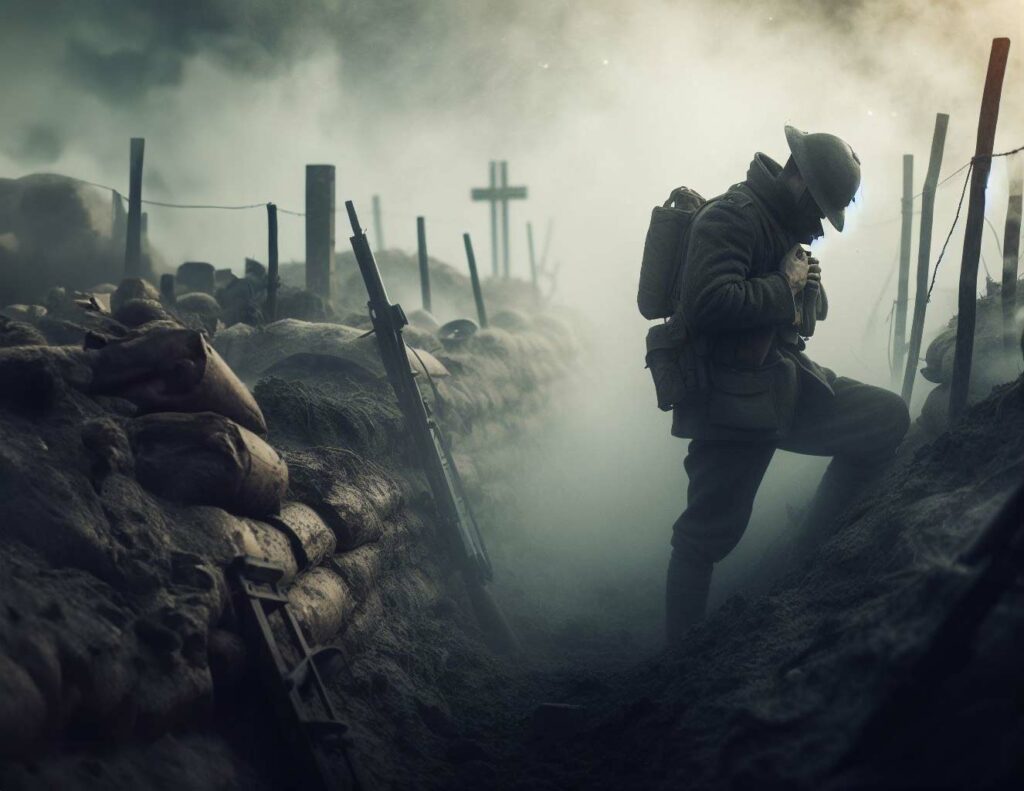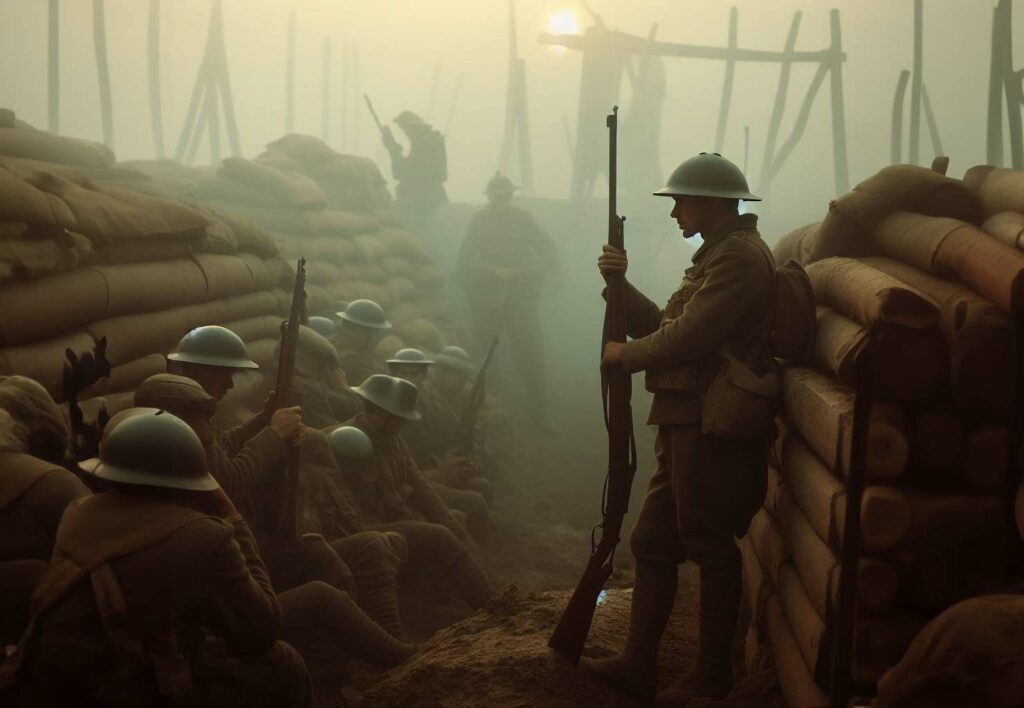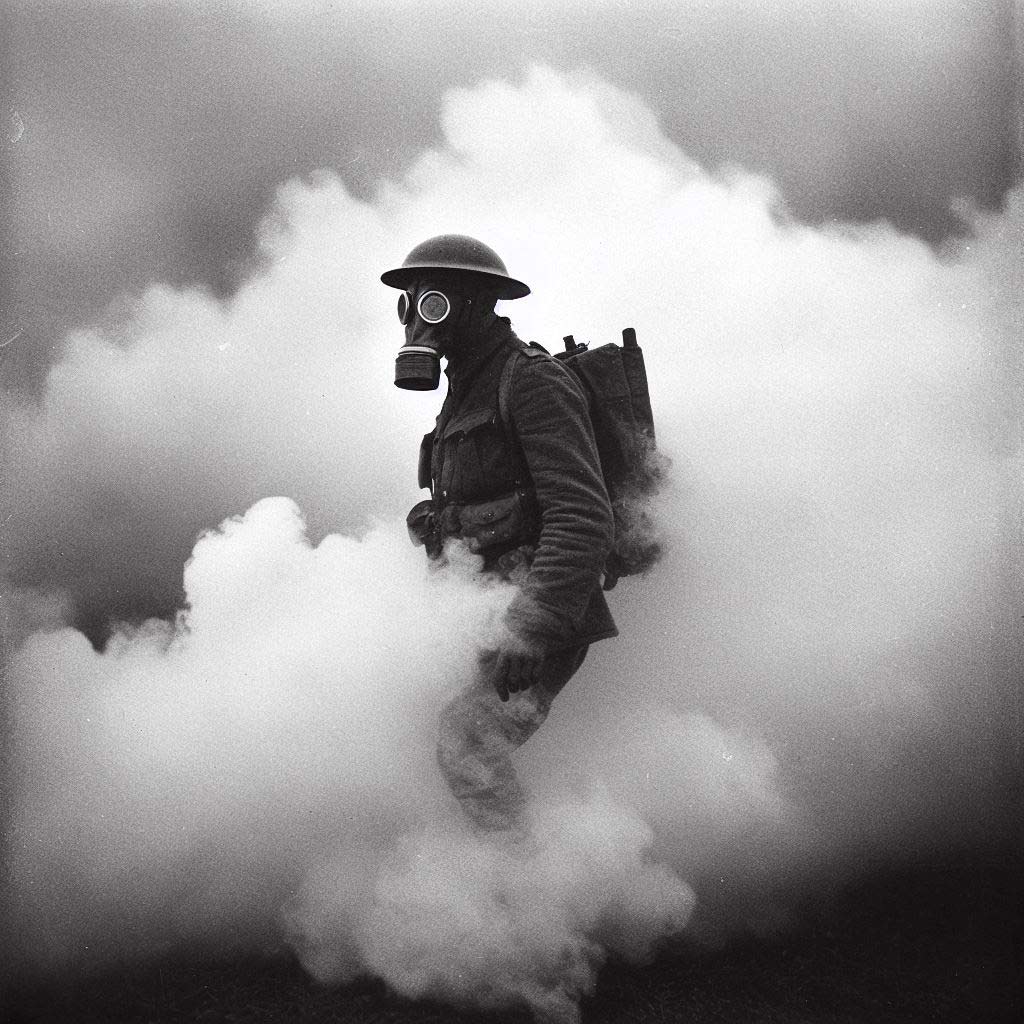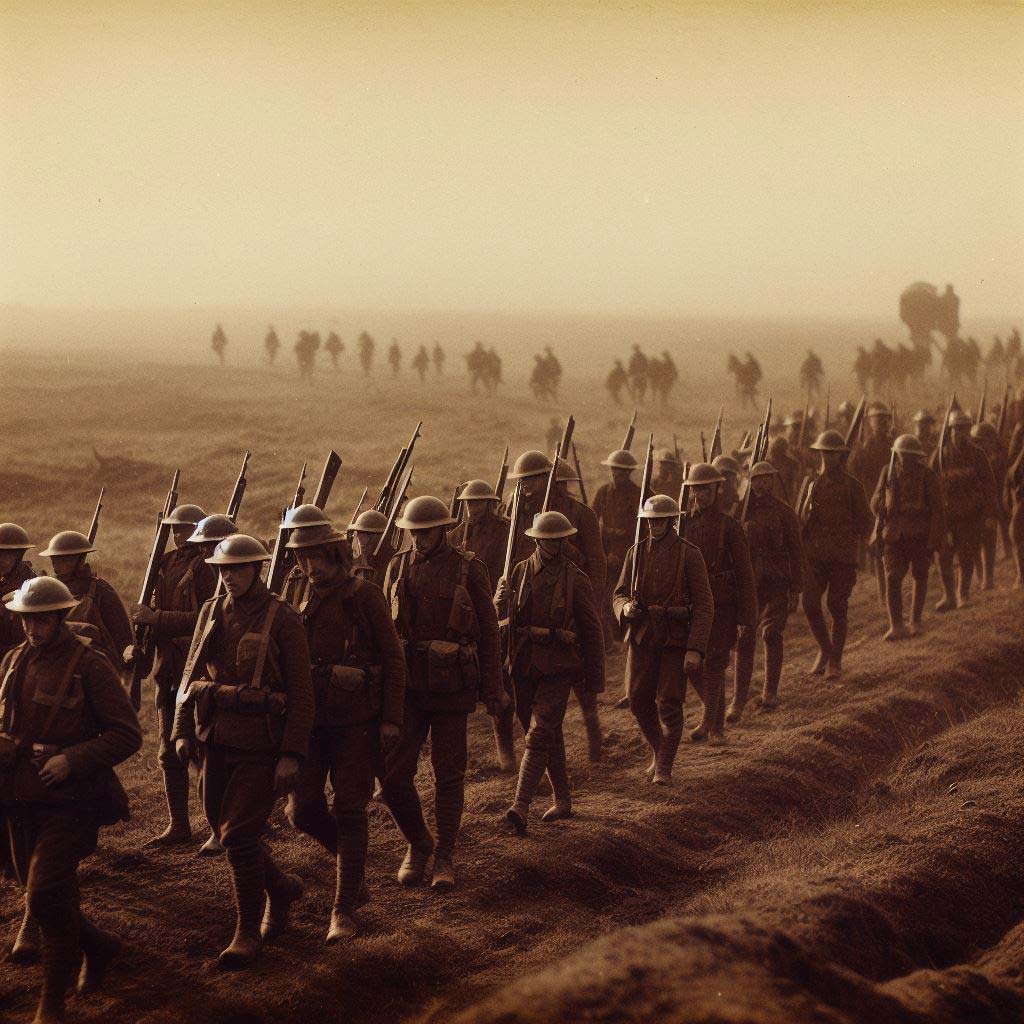Explore the causes, major events, and lasting impacts of World War I in this comprehensive article. Understand the global significance of the 1914-1918 conflict.
World War I in brief
- World War I was a huge global conflict that lasted from 1914 to 1918.
- Many countries fought in it, mainly because of disputes over land, power, and alliances.
- It started after the assassination of Archduke Franz Ferdinand of Austria-Hungary.
- New weapons and fighting methods made it one of the deadliest wars in history.
- The war ended with many changes in countries’ borders and led to World War II.
The war primarily involved two groups: the Allies (including France, Britain, Russia, Italy, and later the U.S.) and the Central Powers (mainly Germany, Austria-Hungary, and the Ottoman Empire). The conflict emerged from a complex web of alliances, national rivalries, and imperial ambitions.
Originating in Europe, it had profound global implications, leading to significant political changes and setting the stage for World War II. Its unprecedented scale and devastation also led to major shifts in military tactics and international relations.

Historical Context
The early 20th century was marked by rising nationalism, complex alliances, and colonial competition, creating a volatile international environment. The major European powers were divided into two main alliances: the Triple Entente (France, Russia, and Britain) and the Triple Alliance (Germany, Austria-Hungary, and Italy).
Involved Parties
- Allies: Initially, France, Britain, and Russia, joined later by Italy, Japan, and the United States.
- Central Powers: Primarily Germany, Austria-Hungary, the Ottoman Empire, and Bulgaria.
Significant Figures
- Kaiser Wilhelm II (Germany)
- Tsar Nicholas II (Russia)
- King George V (Britain)
- President Woodrow Wilson (USA)
- Emperor Franz Joseph I (Austria-Hungary)
Causes of the War
Primary Causes
Assassination of Archduke Franz Ferdinand
- Event: On June 28, 1914, Archduke Franz Ferdinand of Austria-Hungary was assassinated in Sarajevo by Gavrilo Princip, a member of a Serbian nationalist group.
- Immediate Impact: Austria-Hungary, suspecting Serbian involvement, issued an ultimatum to Serbia, leading to a refusal and mobilization of forces.
- Chain Reaction: The complex web of alliances came into play. Russia, allied with Serbia, began to mobilize. Germany, allied with Austria-Hungary, declared war on Russia and subsequently on Russia’s ally, France.
- Global Escalation: The involvement of major powers and their respective colonies and allies quickly escalated the conflict from a regional to a global war.
Nationalism
- Rising Nationalism: The late 19th and early 20th centuries saw a surge in nationalism in Europe. People identified strongly with their nation, often leading to a sense of superiority over others.
- Internal Tensions: Nationalistic fervor contributed to internal tensions within multi-ethnic empires like Austria-Hungary and the Ottoman Empire.
- Pan-Slavism: In Eastern Europe, Slavic nationalism, especially among Serbs, clashed with the interests of Austria-Hungary, fueling regional tensions.
- Aggressive Policies: Nationalistic beliefs often translated into aggressive foreign policies, as countries sought to assert their dominance and protect their national interests.
Imperial Ambitions
- Colonial Rivalries: The major European powers were competing for colonies and spheres of influence around the world, particularly in Africa and Asia.
- Economic Interests: Colonies were seen as crucial for economic prosperity, providing raw materials, markets, and opportunities for investment.
- Power Projection: Control of colonies was also a matter of national prestige and a way to project power globally.
- Conflicts: These imperial ambitions led to conflicts and rivalries, most notably between Britain and Germany, and France and Germany.
Militarism
- Arms Race: The years leading up to WWI saw a significant build-up of military forces and arms, particularly in Germany and Britain (naval race).
- Glorification of the Military: Military strength was seen as a symbol of national power. There was a widespread belief that military might was essential for maintaining and expanding a nation’s position in the world.
- Influence of Military Leaders: Military leaders gained increasing influence in policy-making, often advocating for a more aggressive stance in international affairs.
- Preparedness for War: The extensive militarization meant that nations were not only more capable of waging war but also more inclined to resort to military solutions for international disputes, under the belief that military strength would deter aggression or quickly resolve conflicts.
Secondary Causes
- Complex Alliances: The web of alliances meant that a conflict between two countries could quickly involve others.
- Economic Rivalries: Industrial and economic competition, especially between Britain and Germany, fueled antagonism.
Underlying Tensions
Ethnic and territorial disputes, particularly in the Balkans, were a significant source of instability.

Major Events & Turning Points
Chronology of Significant Events
1914: Assassination of Archduke Franz Ferdinand; War Begins
- June 28: Archduke Franz Ferdinand of Austria-Hungary is assassinated in Sarajevo, setting off a chain of events that lead to war.
- July-August: A series of declarations of war are made by the major powers due to complex alliances.
- August 4: Germany invades Belgium, leading Britain to declare war on Germany.
- Initial Battles: Early battles include the Battle of the Marne, halting the German advance into France.
1915: Use of Poison Gas at Ypres
- Second Battle of Ypres (April-May): This battle is notable for the first large-scale use of poison gas by Germany. Chlorine gas, released from canisters, causes chaos and high casualties in the Allied trenches.
- Wider Impact: The use of gas marks a new era in warfare, highlighting the brutality and escalating scale of the conflict. It leads to the development of gas masks and a chemical arms race.
1916: Battles of Verdun and the Somme
- Battle of Verdun (February-December): One of the longest and bloodiest battles in WWI. France defends Verdun against a prolonged German offensive. Both sides suffer hundreds of thousands of casualties.
- Battle of the Somme (July-November): Initiated by the British and French to relieve pressure on Verdun. Notable for the first use of tanks in September. It results in over a million casualties, epitomizing the deadly stalemate of trench warfare.
1917: U.S. Enters the War; Russian Revolution
- April: The United States declares war on Germany, influenced by unrestricted submarine warfare and the Zimmermann Telegram, which proposed a German-Mexican alliance.
- U.S. Involvement: The entry of the U.S. provides a significant morale and material boost to the Allies.
- Russian Revolution: Russia undergoes two revolutions in 1917. The February Revolution overthrows the Tsar, and the October Revolution brings the Bolsheviks to power.
- Impact on the War: Russia’s internal turmoil leads to its withdrawal from the war (Treaty of Brest-Litovsk, 1918), allowing Germany to concentrate forces on the Western Front.
These events collectively mark the escalating severity and global impact of World War I, profoundly shaping the course and character of the conflict.
Key Strategies
Trench Warfare
- Definition: Trench warfare involved opposing armies digging miles of parallel trenches as defensive positions. The area between opposing trenches, known as “no man’s land,” was often a deadly ground due to constant fire.
- Western Front: This strategy was most prominent on the Western Front, particularly between Germany and the Allied forces of France and Britain.
- Conditions and Challenges: Soldiers lived in harsh conditions, facing threats like enemy fire, flooding, disease, and vermin. Trenches varied from deep, fortified systems to shallow, temporary ones.
- Stalemate: Trench warfare led to a stalemate, especially on the Western Front, as it was difficult for either side to advance significantly without incurring heavy losses.
- High Casualties: The nature of trench warfare, especially during assaults across no man’s land, led to high casualties, making it one of the most lethal forms of combat in the war.
Naval Blockades
- Purpose: Naval blockades were used to restrict the enemy’s ability to trade and resupply, aiming to weaken their war economy and military capability.
- British Blockade of Germany: The Royal Navy’s blockade was particularly effective. It significantly restricted German access to vital supplies, including food and military resources, contributing to civilian hardship and weakening the German war effort.
- German Counter-Blockade: Germany attempted a counter-blockade using U-boats (submarines). Their unrestricted submarine warfare targeted not only military but also civilian and neutral ships, aiming to cut off Britain from overseas resources.
- Effectiveness and Controversy: While effective in restricting supplies, naval blockades and submarine warfare were controversial due to their impact on civilians and neutral countries. The sinking of passenger ships like the Lusitania by German U-boats contributed to turning public opinion against Germany, notably influencing the United States to join the war on the side of the Allies.
Both trench warfare and naval blockades were key strategies in World War I that demonstrated the industrialized and total nature of the war, where civilian and military resources were integrally linked, and the boundaries of warfare were expanded in terms of both technology and impact.
Turning Points
- Entry of the United States: Provided a significant boost to the Allies.
- Russian Withdrawal: Following the Bolshevik Revolution, Russia exited the war.

International Involvement & Reactions
Allies and Treaties
- The intricate system of treaties and alliances played a crucial role in the war’s expansion.
- The U.S. joined the Allies in 1917, tipping the balance.
International Meetings
- Various peace efforts and conferences occurred, but most failed until the war’s end.
Role of International Organizations
- The League of Nations was formed after the war to prevent future conflicts.
Consequences & Aftermath
Casualties
- Estimated 16 million deaths and 20 million wounded.
- Significant civilian casualties due to new warfare technology and strategies.
Economic Impact
- Massive economic burdens on all involved nations.
- Reconstruction needs and war debts, particularly in Europe.
Social and Cultural Implications
- Shifts in societal norms, partly due to the war’s impact and the role of women in wartime economies.
- Psychological impacts, known as “shell shock” or PTSD.
Treaty Signings
- The Treaty of Versailles (1919) notably penalized Germany and redrew European borders.
Legacy & Long-Term Impact
Legacy & Long-Term Impact of World War I
Geopolitical Landscape
Collapse of Empires
- Ottoman Empire: The war resulted in the disintegration of the Ottoman Empire. The Treaty of Sèvres (1920) and the subsequent Treaty of Lausanne (1923) led to the loss of its Middle Eastern territories, paving the way for the modern states of Turkey, Iraq, Syria, and others.
- Austro-Hungarian Empire: This multi-ethnic empire fragmented into several nation-states, including Austria, Hungary, Czechoslovakia, and parts of Yugoslavia, radically altering Central Europe’s political landscape.
- Russian Empire: The Russian Revolution, exacerbated by the strains of WWI, led to the fall of the Tsarist regime and the eventual rise of the Soviet Union, a major shift in global politics.
Redrawing of National Boundaries
- The post-war treaties, particularly the Treaty of Versailles, redrew the map of Europe. New nations were created, and borders were shifted, often without regard to ethnic, cultural, or historical considerations, leading to future ethnic and territorial disputes.
Setting the Stage for World War II
- The Treaty of Versailles imposed harsh reparations and territorial losses on Germany. These punitive conditions, coupled with the treaty’s “war guilt” clause, fostered deep resentment and economic hardship in Germany, creating fertile ground for the rise of Adolf Hitler and the Nazi Party.
- The desire for revenge and territorial revision in Germany, as well as similar sentiments in Italy and Japan, directly contributed to the outbreak of World War II.
Enduring Tensions
Unresolved Issues from Peace Treaties
- The peace settlements, particularly Versailles, failed to address underlying ethnic and national grievances. For example, the creation of new states in Eastern Europe left many ethnic minorities dissatisfied, leading to tensions that persisted throughout the 20th century.
- The League of Nations, established to maintain peace, lacked the authority and military power to enforce its decisions, rendering it ineffective in resolving disputes that arose from the treaties.
Harsh Penalties and Future Conflicts
- The economic and territorial penalties imposed on the Central Powers not only led to economic distress but also to political instability. This instability was instrumental in the rise of fascist regimes in Germany and Italy.
- The sense of injustice and desire for revision or revenge in these nations directly contributed to the outbreak of World War II.
In conclusion, the legacy of World War I significantly shaped the geopolitical landscape of the 20th century. The collapse of empires, the creation of new nation-states, and the deep-seated grievances resulting from the peace treaties had far-reaching impacts, laying the groundwork for World War II and shaping international relations for decades to come.
Commemorations and Cultural Productions
- The war is commemorated in numerous memorials, literature, and films, shaping public memory and historical understanding.
Lessons and Influence
Influence on Military Tactics
- Development of Combined Arms: WWI saw the beginnings of combined arms tactics, integrating infantry, artillery, and later tanks and aircraft. This integration would be crucial in later conflicts.
- Trench Warfare Lessons: The stalemate and casualties of trench warfare led military thinkers to develop new strategies, including blitzkrieg (lightning war) used in WWII, emphasizing speed and surprise.
- Technological Innovation: The war accelerated technological advancements in weaponry, aviation, and communications, influencing future military tactics.
Impact on International Diplomacy
- League of Nations: The formation of the League of Nations aimed to provide a forum for resolving international disputes peacefully, though it had limited success.
- Concept of Collective Security: WWI led to the idea that international peace was a collective responsibility, an idea that would later influence the formation of the United Nations.
- Treaty Negotiations and Reparations: The Treaty of Versailles and other treaties reshaped Europe’s map but also sowed resentment, particularly in Germany, influencing future diplomatic relations.
The Concept of Total War
- Mobilization of Societies: WWI demonstrated how modern warfare involved not just the military but the entire resources of nations, including economic, industrial, and civilian sectors.
- Propaganda and Public Opinion: The war saw the extensive use of propaganda to mobilize public support, control information, and demonize the enemy, practices that became even more prominent in future conflicts.
- Economic Warfare: The concept of economic warfare, including blockades and the disruption of trade routes, highlighted the total nature of war, where economies and societies were as much a part of the war effort as the military.
Long-Term Influence
- Military Doctrine and Planning: The experiences of WWI influenced military doctrines and planning in the interwar period and WWII.
- Changes in Warfare Ethics and Laws: The brutality and new weapons of WWI (like chemical warfare) led to changes in the international laws of war and efforts to regulate warfare to prevent inhumane practices.
- Precedent for International Cooperation and Conflict Resolution: Despite its shortcomings, the post-WWI peace process set a precedent for international cooperation in conflict resolution, influencing later international institutions and diplomatic efforts.
World War I’s profound influence on military tactics, international diplomacy, and the notion of total war reshaped future conflicts and the international order, laying groundwork for the modern era of warfare and international relations.

Conclusion
World War I was a pivotal event in history, reshaping nations and international relations. Its legacy, marked by the tragedy of immense human loss and geopolitical upheaval, serves as a reminder of the consequences of global conflict. Its relevance persists, offering lessons in diplomacy, the dangers of nationalism and militarism, and the importance of international cooperation.
Back to the Wars Section.